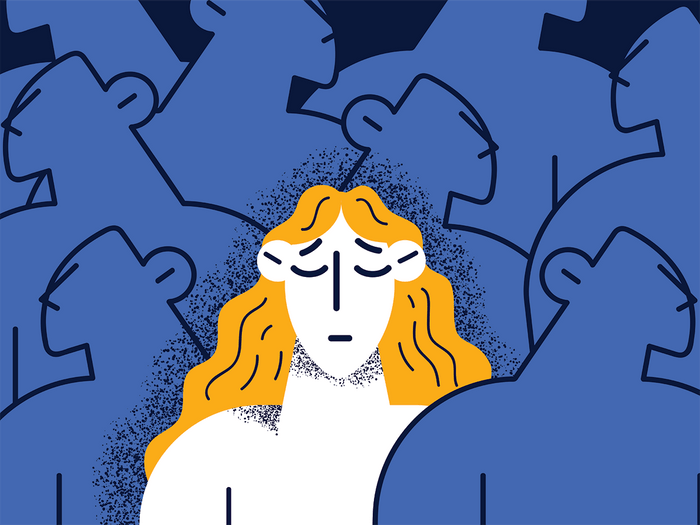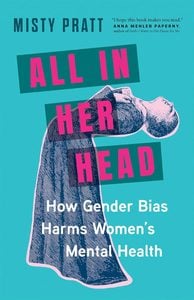For Women, There’s a Link Between Burnout and Depression

In All in her Head: How Gender Bias Harms Women’s Mental Health, science writer Misty Pratt explores why women are twice as likely to be diagnosed with mood disorders than men.
“Today’s workplace thinks and operates much as it did in the 1950s, when people expected the world to be neatly divided into two separate and unequal worlds: the man in the gray flannel suit who could devote himself entirely to work in one, and, in the other, his homemaker wife, taking care of everything and everyone else,” writes Brigid Schulte, author of Overwhelmed: Work, Love, and Play When No One Has the Time. However, this idyllic portrait of work-home life was always a myth, reserved mostly for upper-middle class white families but never the reality for lower-middle-class and working-class families and women from racialized communities.
“For most women, the luxury of being a housewife, simply caring for children, cooking and cleaning and creating a peaceful haven for the hard-worked husband who brought home the bread at the end of the day, was only ever an illusion created by the middle classes,” writes researcher Amanda Wilkinson for The Guardian. Wilkinson’s research has revealed that most women in the nineteenth and early twentieth centuries held nontraditional working roles in agriculture, warehouses, and manufacturing.
The heady days of the 1950s in suburban North America seem to be a bit of a blip in our historical understanding of women and work. The 1950s and subsequent feminist revolution also painted a picture of choice, which has spilled over into our twenty-first-century conversations about “working moms” versus “stay-at-home moms,” as though somehow everyone can freely choose which camp to join if they start a family. Dig a little deeper, and you’ll find that some of the “choices” we make about work are a result of social pressures women face and the rigidity and inflexibility of the modern workplace. Often, it feels less like a choice and more like we’re just getting pushed out.
This transitional postwar time also created a popular professional persona, what Schulte calls the “ideal worker”—the individual who puts in 80-hour workweeks and eats, sleeps, and breathes work (likely they’re not doing much actual sleeping and eating). Western capitalist culture continues to idolize this kind of dedication, and we champion it as if it’s a model for success, especially for men and fathers. In the modern economy, the “ideal worker” and “ideal woman” have blended together, with specific gendered expectations for work and home life.
“When we imagine the ‘ideal feminine woman,’ she is a caregiver, she is strong, assertive, but also loving and warm, and is the person people can come to. She is emotionally available all the time, and can juggle it all, in a way that men are never ever expected to do,” says Alani-Verjee. “Even when we can recognize the impossibility of being that woman, it’s still the version that comes to our mind of success . . . we still try so hard to be a version of that, to fit with our values and beliefs and identity.” Because the ideal woman is the benchmark, it always seems like we’re failing, says Alani-Verjee. “If you’re a nurse, a teacher, or a mother, particularly, we love to pay lip service to these people, but we don’t give a shit what we pay them,” says Bethany Johnson, coauthor of the book You’re Doing it Wrong!: Mothering, Media, and Medical Expertise. “You’re supposed to feel good about your job because it’s a nice thing to do.” She points out that once middle-class women were encouraged to work full-time after second-wave feminism, they weren’t offered resources or help for dealing with the mental load. “A lot of people are also struggling because our expectations have gone up for what mothering looks like and what having a family looks like and what the family unit is responsible for doing,” she says.
So, wealthier women invest in private tutoring, swimming and music lessons, purchase ecofriendly products and organic food, and insist their children learn two languages, all in the name of providing them with a super-enriched childhood experience that mothers are usually tasked with managing and organizing. This has been dubbed “intensive mothering,” which some researchers suggest could be something that perpetuates traditional gender roles. And while none of those activities are inherently “bad,” intensive mothering on the whole benefits men by absolving them from doing a lot of the unpaid emotional work. There are also socioeconomic implications, as the bulk of this intensive mothering is carried out by wealthier women in opposite-sex relationships; women with less financial power may feel similar pressures but face greater barriers to achieving the idyllic family life that wealthier women present on social media and blogs.
What’s more, increased pressure to maintain intensive mothering leaves many women exhausted and on the brink of burnout. It’s a form of burnout that arises just as much in the home as it does in the workplace.
***
In much of the medical literature, burnout has been studied as it relates to our adult working roles; a clear line in the sand is drawn between who we are as employees, managers, or entrepreneurs and who we are in the home. The latest revision of the International Classification of Diseases (ICD-11) states that burnout is a phenomenon with three defining characteristics: emotional exhaustion, a sense of detachment from one’s role (or what is called “depersonalization”), and reduced productivity in the workplace. This means that, at least within our medical understanding, we aren’t meant to apply the concept of burnout to our lives outside an occupational context.
I would argue that this makes the concept of burnout—both our cultural understanding and treatment of it—a largely capitalist one. The notion that individuals can “heal” from burnout in order to jump right back into their jobs fails to address the root cause of the problem. There is a fundamental truth that burnout for women is about more than discovering “work-life balance” or tackling inequality in the workplace—it’s also about the mental load (both cognitive and emotional) and how it spills over into our working lives.
In a large cross-sectional study of 2,026 workers from Canada, a deeper exploration of the gendered pathways that lead to burnout identified that women had lower levels of decision latitude, which means they have socially limited access to control and power within the workplace. Women also experienced higher work-to-family conflict, which could mean they struggled more with their recovery from burnout. Strategies to reduce burnout included women investing more time outside the workplace (perhaps through part-time work arrangements), working from home, and in non-work activities like childcare and household responsibilities.
The authors cautioned that while these strategies may help women to feel better, reducing time spent on work activities can lead to fewer career opportunities and likely exacerbates gender inequality in the workplace. This observation isn’t intended to put more pressure on women to set higher goals or to work harder. Instead, it highlights the reality of the modern workplace: less “face time” at the office often means fewer opportunities to get noticed, fewer promotions, and weaker relationships with managers and coworkers.
***
A set of experiments conducted with undergraduate students at the University of Pittsburgh illustrated how women are expected to cater to others. A computer randomly created mixed-gender groups of three people who were tasked with getting one group member to volunteer to click a button, without using any form of communication. (Each student was seated at their own computer, and all decisions were anonymous.) If no one volunteered to click the button, everyone in the group received $1. If someone volunteered, the volunteer received $1.25 while the other two group members each received $2. This continued for 10 decision rounds.
Lo and behold, women were 48 percent more likely to volunteer compared to the men. The researchers hypothesized that women volunteered more because others expected them to. To test this, they reran the experiment with the groups made up of only men or only women. In this case, the all-men and all-women groups ended up having the same success rates in finding a volunteer to click the button and take the pay cut. The researchers concluded that it isn’t that women like to take on extra tasks (often menial jobs that no one else wants to do!); it’s that there’s a social expectation that women will always step up.
Researchers are still trying to tease out the overlapping relationship between burnout and mental illness. There does seem to be a strong link between burnout, depression, and anxiety, but no conclusive evidence that one causes the other. One study of nurses found that participants with significant levels of burnout were more likely to screen positive for any mental disorder, particularly major depressive disorder.
In a study of Finnish employees that measured biomarkers of physiological stress (called “allostatic load”) and depression, the authors found that burnout was indeed putting strain on the body, but that depression explained 60 percent of this association—which means there was a lot of overlap. The study suggests that the association between burnout and depression is likely two-way: burned-out people may be more likely to become depressed, and depressed people are more vulnerable to burnout. However, the path from burnout to depression appears to be stronger.
When women are experiencing burnout in a more general “I’m so exhausted with everything” sense, it is sometimes diagnosed as anxiety or depression. The authors of a 2019 review caution that the similarities between burnout and depression or anxiety could lead to a false diagnosis and that burnout itself might be overlooked. When this happens, treatment solutions may prove ineffective, leading to worsening symptoms or an abandonment of treatment altogether. Treatment for mental illness generally centers on therapy and medication; treatment for burnout would likely encompass more holistic solutions, like time off work to rest, negotiating different working hours with an employer, and self-care strategies including sleep hygiene and exercise. Of course, treatments for these conditions overlap in many ways, but treating burnout as mental illness may mean that the underlying economic and social issues women face are not being addressed.
Though it’s speculative, I would like readers to consider something: What if the high rates of anxiety and depression among women are, in large part, caused by burnout? What if the reason you can’t get out of bed is more about the world you live in, the job you hold (or no longer hold), and the power you lack rather than about you as a person? Personally, this realization completely changed the way I relate to myself and my mental illness. I believe that misdiagnosing burnout feeds the illusion that mental illness is due to a personality flaw, negative mindset, my family’s genes, or an imbalance in my brain rather than an understanding that is closer to the truth: I’m facing a social problem that has real, lived emotional consequences. For some, this realization may be distressing: it means acknowledging that you don’t have as much control over your well-being as you once thought. But I hope that some of you find this freeing, that it lifts the veil shrouding mental illness and sets you on a path to rediscover your own capacity, the ways in which you are limited, and what tiny acts of resistance you can make.

Excerpted from All In Her Head: How Gender Bias Harms Women’s Mental Health by Misty Pratt. © 2024, Misty Pratt. Published by Greystone Books, greystonebooks.com. Reproduced by arrangement with the Publisher. All rights reserved.
Next: Can Treating Inflammation Offer Relief From Depression?




